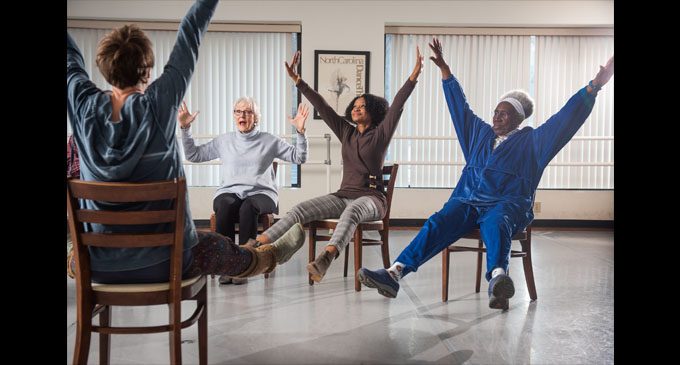Dance for the memories
Participants enjoy dance moves that offer many health benefits.

By Christina E. Hugenschmidt, Ph.D.
The health benefits of dance have been getting a lot of press lately. A New York Times piece called dance the ‘kale’ of exercise for aging, and with good reason – a 2003 study showed that dance was the only leisure-time physical activity associated with lower risk for dementia, and subsequent small trials suggest that dance improves brain health. Dance is particularly intriguing in the context of aging because it combines art with physical, cognitive, and social activity, all of which have known benefits for the aging body and brain.
Winston-Salem has its own NIH-funded clinical trial about the effects of dance, a great fit for the “City of Arts and Innovation.” The IMOVE study examines how dance affects the brains and bodies of older adults experiencing early stages of memory loss. Many people don’t realize it, but changes in walking and balance often accompany memory loss. Studies show that people with memory loss are more likely to fall than others their same age who do not have memory loss, and falls are a main reason people with memory loss visit the emergency room. Memory loss is also linked with decreased social engagement. Dance might be a way to help with both movement and social engagement at the same time.
The pilot study for IMOVE showed that in people with early-stage memory loss, participating in dance movement twice a week for eight weeks improved balance, mood and functional connections in the brain in regions important for motor movement and social engagement. However, the pilot study was small; these effects might not be the same across a larger group of people. Also, it didn’t answer important questions about why the dance movement was helpful. Did the movement increase brain connectivity or the social interactions, or was it important to have movement and social contact together? The current larger study will answer these questions.
The IMOVE study is unique in several ways. First, it uses improvisational movement. Before you quit reading, this does not mean people wear all black or twirl ribbons. Improvisational movement is a modern dance form that uses open-ended movement cues rather than planned choreography. This method has been honed by dancer and choreographer Christina Soriano for people of all ages and abilities in a method she calls IMPROVment®. This means dancers can work to their own level of challenge safely, even remaining seated. It also creates a fun, playful atmosphere because there is not a “right” way to do any movement. Because the movements change rapidly, it is cognitively challenging. At the same time, movements don’t have to be remembered from exercise to exercise or class to class. Another unique aspect of the IMOVE study is that people with memory concerns come with a partner, like a spouse, friend, or family member, creating an opportunity to spend time together.
To learn more about the IMOVE study, contact the IMOVE study team at 336-713-MOVE (713-6683), visit www.wakehealth.edu/beinvolved/IMOVE. Visit www.improvment.us to learn more about the IMPROVment method.
Christina E. Hugenschmidt, Ph.D., is associate professor, Gerontology & Geriatric Medicine, at Wake Forest Health.










